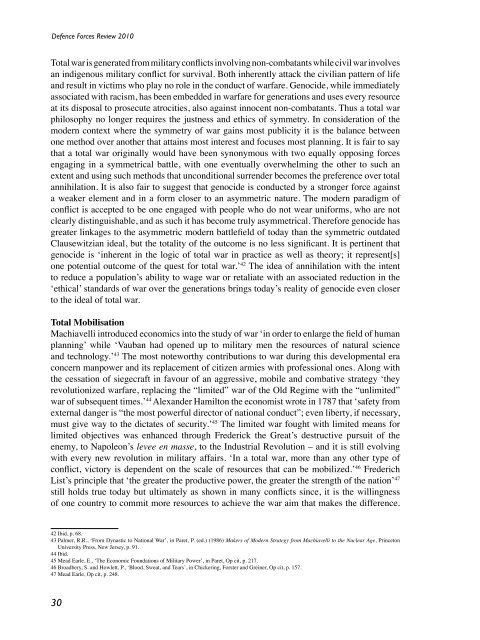Defence Forces Review 2010
Defence Forces Review 2010
Defence Forces Review 2010
You also want an ePaper? Increase the reach of your titles
YUMPU automatically turns print PDFs into web optimized ePapers that Google loves.
<strong>Defence</strong> <strong>Forces</strong> <strong>Review</strong> <strong>2010</strong>Total war is generated from military conflicts involving non-combatants while civil war involvesan indigenous military conflict for survival. Both inherently attack the civilian pattern of lifeand result in victims who play no role in the conduct of warfare. Genocide, while immediatelyassociated with racism, has been embedded in warfare for generations and uses every resourceat its disposal to prosecute atrocities, also against innocent non-combatants. Thus a total warphilosophy no longer requires the justness and ethics of symmetry. In consideration of themodern context where the symmetry of war gains most publicity it is the balance betweenone method over another that attains most interest and focuses most planning. It is fair to saythat a total war originally would have been synonymous with two equally opposing forcesengaging in a symmetrical battle, with one eventually overwhelming the other to such anextent and using such methods that unconditional surrender becomes the preference over totalannihilation. It is also fair to suggest that genocide is conducted by a stronger force againsta weaker element and in a form closer to an asymmetric nature. The modern paradigm ofconflict is accepted to be one engaged with people who do not wear uniforms, who are notclearly distinguishable, and as such it has become truly asymmetrical. Therefore genocide hasgreater linkages to the asymmetric modern battlefield of today than the symmetric outdatedClausewitzian ideal, but the totality of the outcome is no less significant. It is pertinent thatgenocide is ‘inherent in the logic of total war in practice as well as theory; it represent[s]one potential outcome of the quest for total war.’ 42 The idea of annihilation with the intentto reduce a population’s ability to wage war or retaliate with an associated reduction in the‘ethical’ standards of war over the generations brings today’s reality of genocide even closerto the ideal of total war.Total MobilisationMachiavelli introduced economics into the study of war ‘in order to enlarge the field of humanplanning’ while ‘Vauban had opened up to military men the resources of natural scienceand technology.’ 43 The most noteworthy contributions to war during this developmental eraconcern manpower and its replacement of citizen armies with professional ones. Along withthe cessation of siegecraft in favour of an aggressive, mobile and combative strategy ‘theyrevolutionized warfare, replacing the “limited” war of the Old Regime with the “unlimited”war of subsequent times.’ 44 Alexander Hamilton the economist wrote in 1787 that ‘safety fromexternal danger is “the most powerful director of national conduct”; even liberty, if necessary,must give way to the dictates of security.’ 45 The limited war fought with limited means forlimited objectives was enhanced through Frederick the Great’s destructive pursuit of theenemy, to Napoleon’s levee en masse, to the Industrial Revolution – and it is still evolvingwith every new revolution in military affairs. ‘In a total war, more than any other type ofconflict, victory is dependent on the scale of resources that can be mobilized.’ 46 FrederichList’s principle that ‘the greater the productive power, the greater the strength of the nation’ 47still holds true today but ultimately as shown in many conflicts since, it is the willingnessof one country to commit more resources to achieve the war aim that makes the difference.42 Ibid, p. 68.43 Palmer, R.R., ‘From Dynastic to National War’, in Paret, P. (ed.) (1986) Makers of Modern Strategy from Machiavelli to the Nuclear Age, PrincetonUniversity Press, New Jersey, p. 91.44 Ibid.45 Mead Earle, E., ‘The Economic Foundations of Military Power’, in Paret, Op cit, p. 217.46 Broadbery, S. and Howlett, P., ‘Blood, Sweat, and Tears’, in Chickering, Forster and Greiner, Op cit, p. 157.47 Mead Earle, Op cit, p. 248.30
















